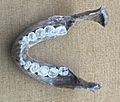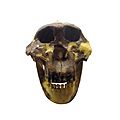Paranthropus boisei facts for kids
Quick facts for kids Paranthropus boiseiTemporal range: Pliocene-Pleistocene
|
|
|---|---|
 |
|
| Scientific classification | |
| Kingdom: | |
| Phylum: | |
| Class: | |
| Order: | |
| Family: | |
| Genus: | |
| Species: |
P. boisei
|
| Binomial name | |
| †Paranthropus boisei (Mary Leakey, 1959)
|
|
Paranthropus boisei was an ancient human relative that lived a very long time ago. It was first called Zinjanthropus boisei and then Australopithecus boisei, but scientists now know it as Paranthropus boisei. This species was one of the largest of its kind, known for its strong jaws and big teeth. It lived in Eastern Africa for about 1.4 million years, from around 2.6 million years ago until about 1.2 million years ago. This time period is known as the Pliocene and Pleistocene epochs. Males of this species were about 4 feet 6 inches tall, and females were a bit shorter, around 4 feet 1 inch.
Contents
Meet Paranthropus Boisei
Paranthropus boisei was a type of hominin, which is a group that includes humans and our closest ancient relatives. It's part of a family tree that eventually led to modern humans. Scientists study their fossils to learn about how they lived and what the world was like millions of years ago.
Where and When It Lived
Paranthropus boisei lived only in Eastern Africa. Fossils of this species have been found in countries like Tanzania, Kenya, and Ethiopia. These areas were likely a mix of grasslands and woodlands back then. They lived during a time when Earth's climate was changing, which affected the types of plants and animals available.
What It Looked Like
Paranthropus boisei had a very strong and robust skull. This means its head bones were thick and sturdy. They had a special ridge on top of their skull called a sagittal crest, which is similar to what you might see on a gorilla. This crest was an anchor point for huge chewing muscles. Their faces were broad and flat, and they had very large molars and premolars, much bigger than those of modern humans. These features suggest they were built for powerful chewing.
What It Ate
Because of their incredibly strong jaws and large, flat teeth, scientists believe Paranthropus boisei ate a diet of tough, fibrous plants. They might have eaten things like roots, tubers, nuts, and hard fruits. Their powerful chewing muscles would have helped them grind down these difficult-to-eat foods. This diet was different from some other early human relatives who might have eaten softer foods or more meat.
How We Know About It
The first important fossil of Paranthropus boisei was discovered by Mary Leakey in 1959 at Olduvai Gorge in Tanzania. She found a nearly complete skull, which was a huge discovery for understanding early human evolution. This skull, nicknamed "Nutcracker Man" because of its powerful jaws, helped scientists learn a lot about this ancient species. Since then, more fossils have been found, giving us a clearer picture of Paranthropus boisei.
Images for kids
-
Map of Paranthropus finds (P. boisei in red)
-
OH 80 femoral shaft (left) and radius (right) Scale bar=1 cm (0.39 in)
-
Male (left) and female (right) western gorilla skulls
See also
In Spanish: Paranthropus boisei para niños









